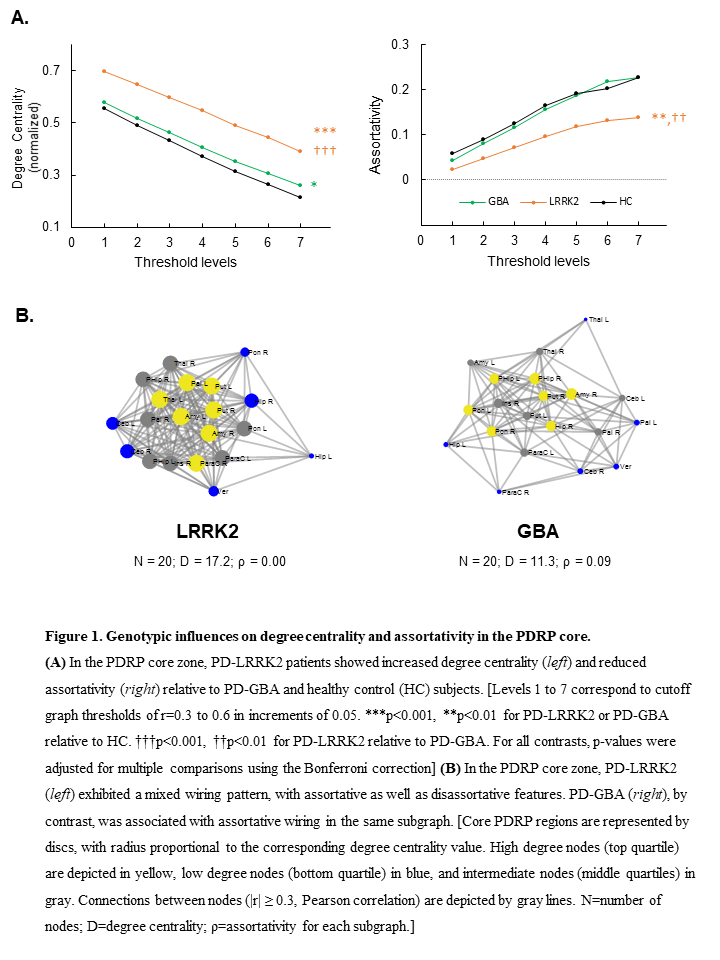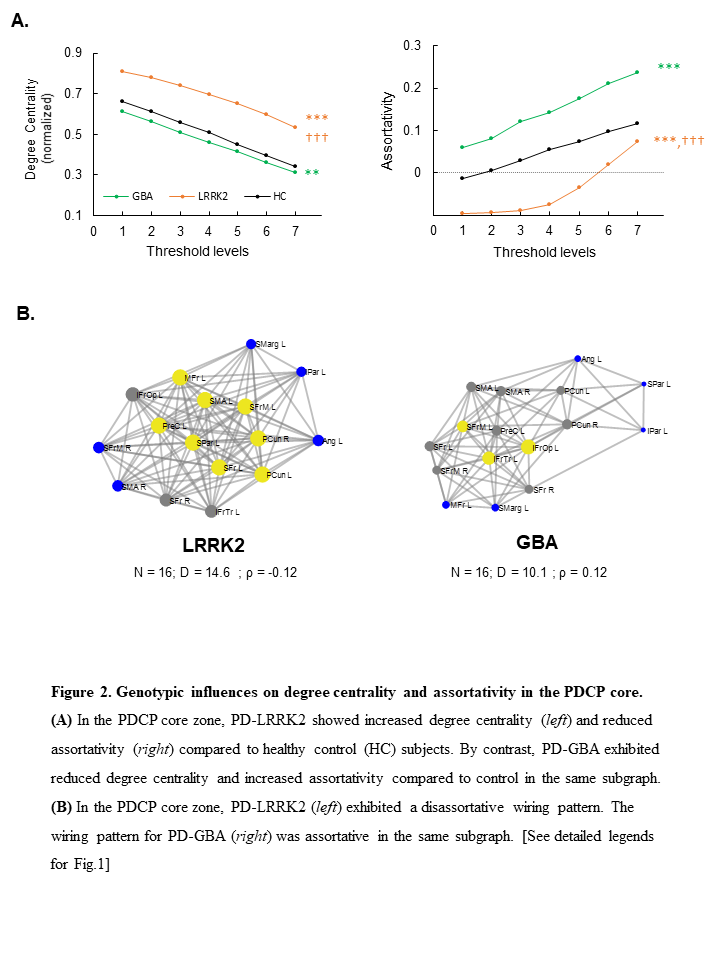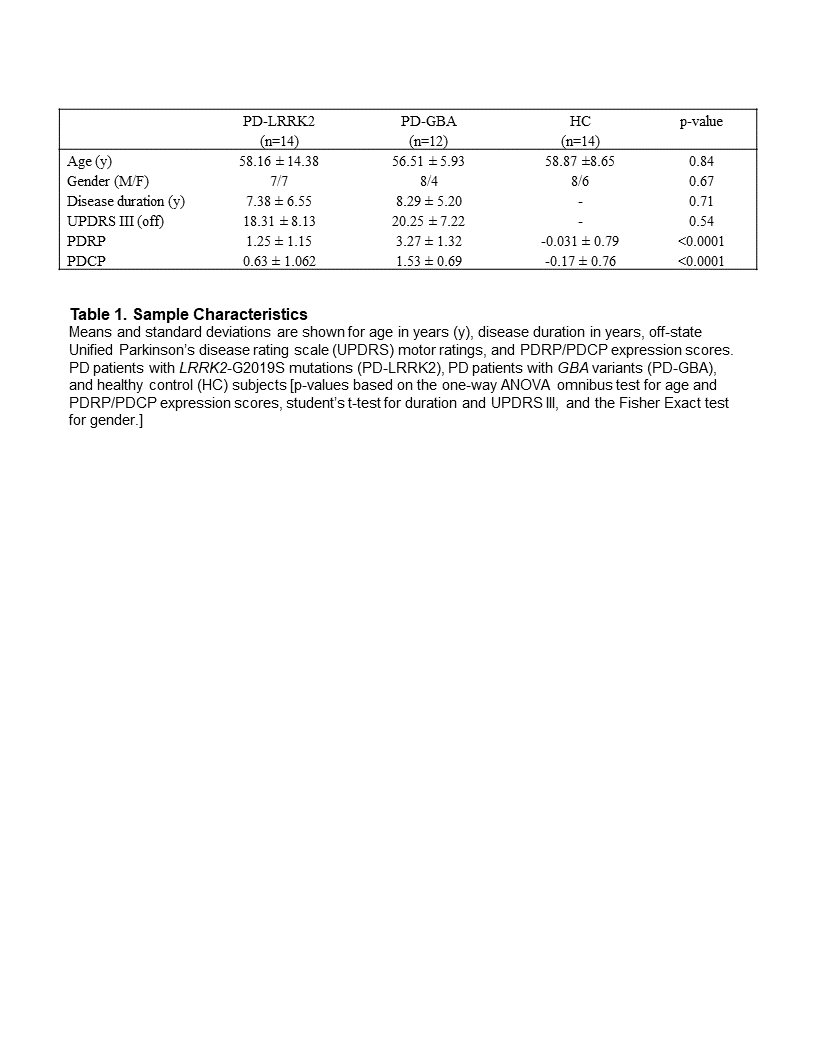Category: Parkinson's Disease: Neuroimaging
Objective: Although disease networks have been identified in Parkinson’s disease (PD) using functional imaging, it is unclear whether these represent maladaptive or compensatory responses to the underlying pathology. Here, we sought to disambiguate these changes by measuring assortativity, the tendency of connections to link together nodes of similar degree in a disease network. We predicted that assortative networks will be maladaptive by virtue of their inefficiency and vulnerability, whereas disassortative networks were by contrast predicted to be compensatory by virtue of their efficiency and robustness.
Background: PD is characterized by distinct, validated metabolic networks associated with the motor and cognitive manifestations of the disorder (PDRP and PDCP) [1]. These networks are elevated in PD patients with the LRRK2 mutation or GBA variants [2], which respectively are associated, with slow and more aggressive disease progression [3, 4]. While the two PD genotypes differed in the density and location of functional connections within each of the networks [1], it is unclear whether these changes represent maladaptive or compensatory responses to the underlying pathology.
Method: To examine the genotypic differences in network organization, the PDRP and PDCP were partitioned into core and periphery zones based on metabolic valence. We measured degree centrality (number of edges) and assortativity (wiring pattern) in each subgraph. For each network and subgraph, we compared corresponding measurements from PD patients carrying the LRRK2-G2019S mutation (PD-LRRK2) and their matched counterparts with GBA variants (PD-GBA) [table1].
Results: In the PDRP core zone, PD-LRRK2 patients showed increased degree centrality and reduced assortativity relative to PD-GBA and healthy control (HC) subjects [figure 1]. In the PDCP core zone, PD-LRRK2 showed increased degree centrality and reduced assortativity compared to HCs. By contrast, PD-GBA exhibited reduced degree centrality and increased assortativity compared to HCs in the same subgraph [figure 2].
Conclusion: In PD networks, core assortativity was increased in patients with GBA variants, in which the clinical phenotype tends to be more aggressive. By contrast, this measure was reduced in patients with the LRRK2 mutation, which is associated with slower progression. The findings show that maladaptive and compensatory wiring responses can be distinguished by assortativity.
References: [1] Schindlbeck KA, Eidelberg D. Network imaging biomarkers: insights and clinical applications in Parkinson’s disease. Lancet Neurol 2018; 17: 629-40. [2] Saunders-Pullman R, Mirelman A, Alcalay RN, Wang C, Ortega RA, Raymond D, et al. Progression in the LRRK2-Asssociated Parkinson Disease Population. JAMA Neurol 2018; 75: 312-9. [3] Cilia R, Tunesi S, Marotta G, Cereda E, Siri C, Tesei S, et al. Survival and dementia in GBA-associated Parkinson’s disease: The mutation matters. Ann Neurol 2016; 80: 662-73. [4] K.A. Schindlbeck, A. Vo, N. Nguyen, C.C. Tang, M. Niethammer, V. Dhawan, V. Brandt, R. Saunders-Pullman, S.B. Bressman, D. Eidelberg, LRRK2 and GBA Variants Exert Distinct Influences on Parkinson’s Disease-Specific Metabolic Networks, Cereb. Cortex. (2019).
To cite this abstract in AMA style:
K. Schindlbeck, A. Vo, N. Nguyen, A. Rommal, C. Tang, M. Niethammer, V. Dhawan, R. Saunders-Pullman, S. Bressman, D. Eidelberg. Distinct compensatory and maladaptive wiring patterns in genotypic Parkinson’s disease [abstract]. Mov Disord. 2020; 35 (suppl 1). https://www.mdsabstracts.org/abstract/distinct-compensatory-and-maladaptive-wiring-patterns-in-genotypic-parkinsons-disease/. Accessed January 4, 2026.« Back to MDS Virtual Congress 2020
MDS Abstracts - https://www.mdsabstracts.org/abstract/distinct-compensatory-and-maladaptive-wiring-patterns-in-genotypic-parkinsons-disease/



